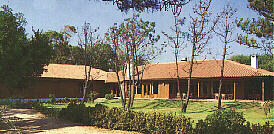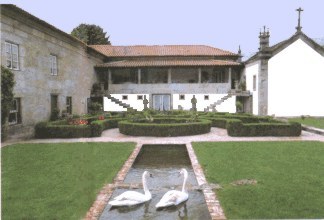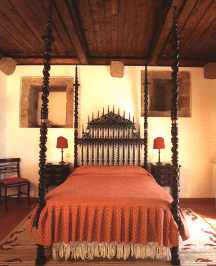|
| |
|
| |
Northern Challenges
By Carla Harvey, TravelGolf.com StaffWriter
With thanks to Carla Harvy and the editor of TravelGolf.com
Portugal becomes richer in colour contrasts as you drive north, the
greens seem almost black and the soil is a deep bronze. When I reached
Amarante, the air was clear and crisp.

Part of Amarante’s attractiveness is its hilly nature; a buggy
is a must if you intend to enjoy the game. As Joao Silva, Managing Secretary
at Soc. Golfe De Amarante, S.A. says,
“To get good scores on this course, you have to be in good shape. Very
seldom is the level of the ball and your feet the same.”
‘Hmm,’ I thought, remembering a well-told tale from the previous
day. One of the city’s leading entrepreneurs had slid gracefully down to
the lake on Amarante’s Number 3, on his heels all the way but never
sacrificing his innate sense of style. After he had promised the family
fortune to his accompanying son, he was hoisted out by that canny family
member aided by the trusty iron that had joined him on his slalom.
Number 3 also offers a dogleg to the left, your drive is blind so Joao
counsels leaving the drive short so that your second shot may reach
the green.
| On the Road | |
| I found the Portuguese police forgiving of venial sins such as driving around on the inside of a walled town without permission. They would peer into the car, take note of the clubs in the back seat, nod to each other knowingly and say, “Ah, golfe,” after which I was waved on. I leave this to your interpretation: a) do golfers evoke an image of inherent idiocy that must be tolerated, b) are golfers outside of the law, c) don’t know? Whatever, as soon as I realised that the powers that be were vulnerable to players, I kept clubs purposely on display and advise all who drive there to do the same. |
Additional to hills, the course is characterized by small, undulating greens; honed-up putting will help as it is rare to find yourself in a position to make a straightforward putt.
Weekends during the high season might require booking; normally it isn’t necessary. Many amateur championships are played here and Amarante is host to the Portuguese National Championship with prize money increasing by one million Escudos a year.
Not far from Amarante Golf Club is Casa de Juste. The house is lovely, the rooms comfortable, the surrounding countryside verdant and soothing and the owners easy-going. Casa de Juste is at the centre of vineyards producing the grapes for a thriving wine company. The family estate at Quinta da Aveleda has extensive vineyards. Visits and wine tastings can be arranged; if time permits, do not miss the opportunity.
Casa de Juste has its own formal gardens overseen by two proud swans.
The guest-house, whose spacious communal lounge overlooks the gardens,
contains five comfortable double bedrooms. A
swimming pool is set above the vineyards. In July 2001, a restaurant
was on the verge of completion: a finishing touch that will be appreciated
by guests who prefer to stay put after the day’s activities.
A
swimming pool is set above the vineyards. In July 2001, a restaurant
was on the verge of completion: a finishing touch that will be appreciated
by guests who prefer to stay put after the day’s activities.
Bicycles are available for exploration of the local villages; nearby stables provide horse-riding facilities. Two hundred metres from the main house, owners run a gift shop stocked with their own wines and cheeses, olive oil and local crafts. Should the big city beckon, take the local train to Porto (30 minutes away) and discover contrasts between the old and new metropolis.
One hour’s drive from Amarante and the next golf course, Ponte
de Lima came into view. The golf club and a
equestrian centre opened in 1995.
| Follow the Signs | |
| One of Portugal’s Seven Deadly Sins is its demented approach to sign-posting. The citizenry are the first to concur, chuckling merrily. “Yes, yes, terrible; it’s a wonder anyone ever reaches their destination.” Their agreement aside, little is being done to improve the situation. Following signposts is easy only on express highways. (Speaking of toll roads: always carry escudos to pay toll. Neither credit cards nor foreign currency are accepted.) How to cope with the signs: ask gas station attendants, taxi drivers, anyone looking half-way bright on the street. Keep the phone number of your destination handy and call when you despair. |
The layout is varied and interesting and involves playing across a mountain. The first nine holes offers exceptional views from the top on Holes 2 and 8. Number 3 may be Portugal’s longest hole; if not, it seems so. It is 622 metres long, flanked by forest and with a dogleg right. Players have an easier, flatter time of it on the second nine, especially if they’ve taken advantage of the club restaurant and stopped for lunch and recuperation. The restaurant is lively and very popular with local business people as well as golfers.
Ponte de Lima provides Strokesavers free which keeps players in a good mood. Many greens are invisible from the tees owing to doglegs and other incidentals. Further (also free) advice from the Course Director is to keep your driver out of play during the first nine; use a 3 wood instead. “The course requires you to think,” he added.
The single most striking aspect of Ponte de Lima is its natural features.
Trees, mountains, vineyards and flowers typify the Minho region and are
more integral to this particular course than to any other in the area.
Scots engineer Ian MacPherson was insistent that no one meddle with nature.
Arguments (there were many) were met with adamant refusal to compromise.
We are indebted to him for his intractability, for the golf course is far
better as a result of it.

I stayed at Casa
da Lage. Rightly called one of the ‘noble houses of Portugal’,
it is set in luxuriant countryside. Dating from the 14th century, it possesses
both antiquity and beauty. The house exemplifies gracious living. The grounds
are lush and extensive, the vineyards flourishing. This is a good walking
area with inviting paths to follow.
Golfers travelling in small groups find Casa da Lage ideal. In the manor house itself, there are three double bedrooms and a twin bedroom. Casa Tulha is a well-equipped guest cottage which contains six twin bedrooms, some of which have extra sofa beds. There are kitchen facilities, a large living room and a fireplace. In total, more than 20 can enjoy calling Casa da Lage home while playing golf at Ponte de Lima.
Facilities for guests of both manor house and cottage include an indoor swimming pool and large lounge. The only delicious thing that self-catering guests miss out on are the delectable breakfasts served in the main house.
Several restaurants are nearby. Outstanding among them is ‘Carvalheira’, which does excellent steaks in a variety of ways. A bountiful array of appetisers are delicious. Informal in style, a smart/casual ambience prevails.
From here to Viana do Castelo was a brief and sunny half hour drive. Two golf courses awaited.
| PORTUGAL - ACCOMMODATION BY TYPE | |||
| Portugal hotels | Pousadas | Manor Houses | Portugal inns |
| Portugal villas | Portugal cottages with shared pool | Golf Courses | |
| PORTUGAL - ACCOMMODATION BY REGION | |||
| Algarve | Alentejo | Lisbon Coast | Tagus Valley |
| Beiras | Porto and Douro | Alto Minho | Azores and Madeira |
| SPAIN | |||
| Paradores of Spain | |||